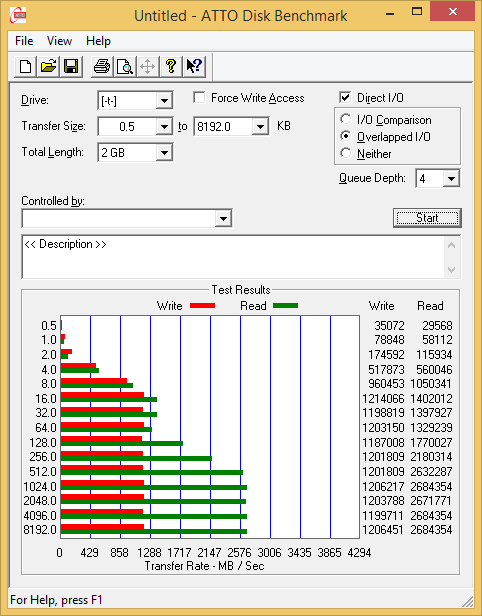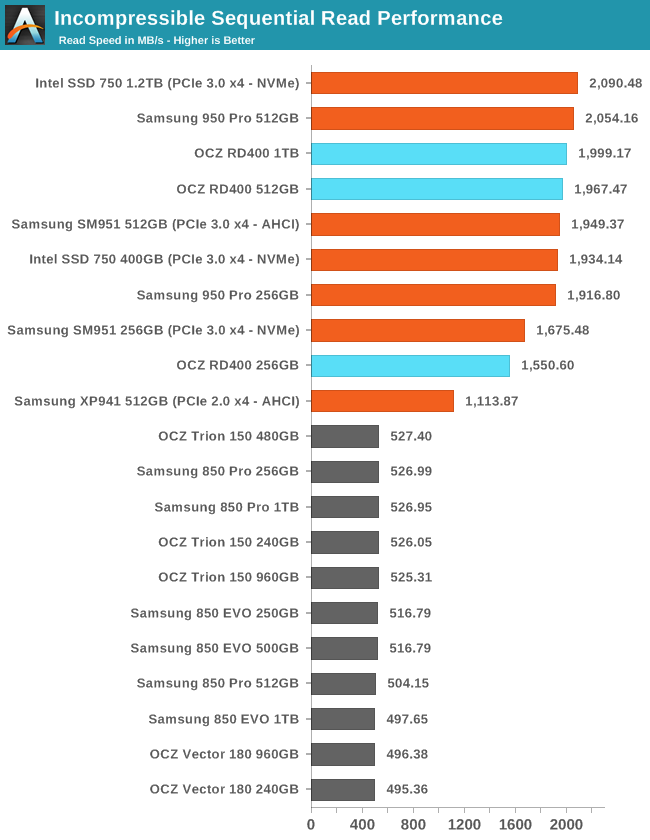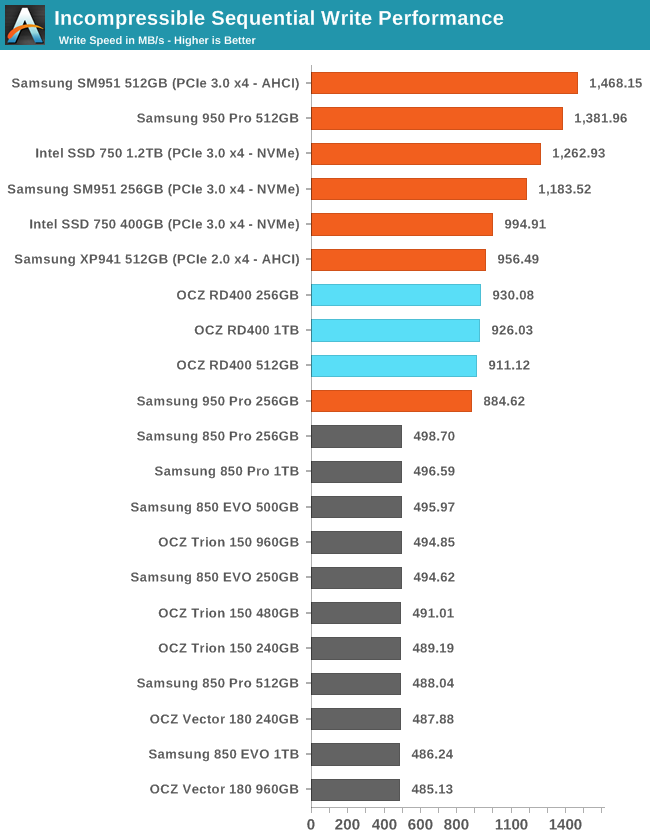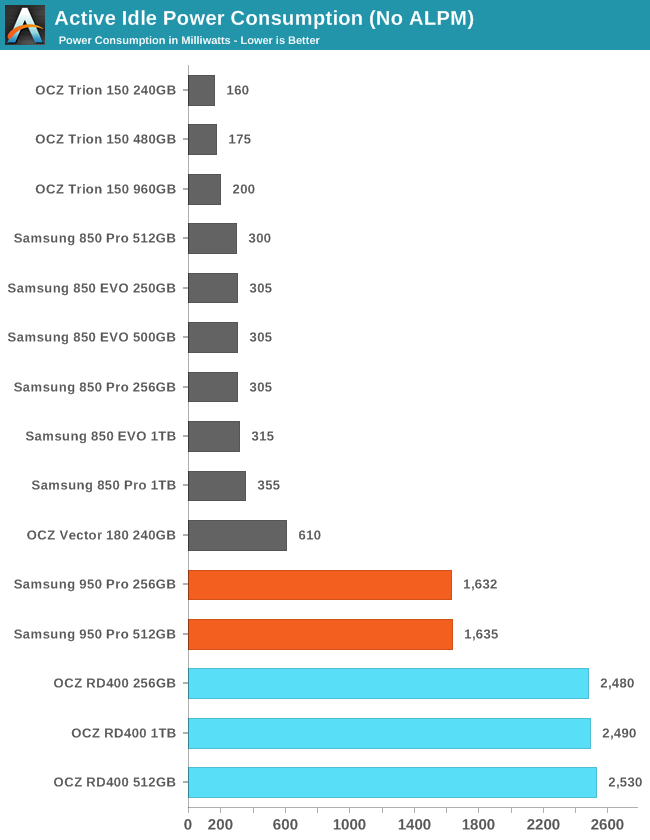The Toshiba OCZ RD400 (256GB, 512GB, 1TB) M.2 PCIe SSD Review
by Billy Tallis on May 25, 2016 8:02 AM ESTATTO
ATTO's Disk Benchmark is a quick and easy freeware tool to measure drive performance across various transfer sizes.
 |
|||||||||
The lower write speed of the 256GB RD400 is clearly visible. All three models show essentially no performance scaling from 16kB to 64kB transfer size but only reach full performance for 512kB or larger transfers.
AS-SSD
AS-SSD is another quick and free benchmark tool. It uses incompressible data for all of its tests, making it an easy way to keep an eye on which drives are relying on transparent data compression. The short duration of the test makes it a decent indicator of peak drive performance.


The 256GB RD400 lags a bit behind the competition for read speed and all three are near the bottom of the PCIe segment for write speed.
Idle Power Consumption
Since the ATSB tests based on real-world usage cut idle times short to 25ms, their power consumption scores paint an inaccurate picture of the relative suitability of drives for mobile use. During real-world client use, a solid state drive will spend far more time idle than actively processing commands. Our testbed's PCIe link state power management support is broken, so only active idle power consumption is reported. This is realistic for most desktop scenarios, but a properly configured mobile system can potentially save power by enabling link power management for PCIe and SATA.

The 12V to 3.3V conversion done by the PCIe to M.2 adapter card bundled with the RD400 is providing some overhead to idle power, but most of this poor showing comes down to a lack of usable PCIe power management on common desktop platforms.










40 Comments
View All Comments
Samus - Wednesday, May 25, 2016 - link
I'm sure a multi billion dollar conglomerate decided to convert the 12v PCIe rail over drawing from the weak 3.3v rail for a reason. Probably something as simple as firmware flashing compatibility. Flashing firmware causes enormous voltage spikes that would easily surpass 10 watts @ 3.3vjjj - Wednesday, May 25, 2016 - link
It's a bit weird to state that the Samsung is the fastest when it loses in write and mixed workloads.Your own benchmark is read heavy but maybe not all readers care most about read perf.
LostWander - Wednesday, May 25, 2016 - link
Read seems to be the most common trait people look for, so if they had to pick one I would agree on that. Kinda odd to give it the title though with no single drive leading in more than a couple benchmarks, it's only "the fastest" in relatively specific categoriesBilly Tallis - Wednesday, May 25, 2016 - link
The Samsung 950 Pro is clearly faster on the ATSB Heavy test which writes more than twice as much data as it reads. If you have a workload that is so much more write heavy that the RD400 comes out ahead, then it's quite atypical and you shouldn't expect our general-audience recommendations to apply.DanNeely - Wednesday, May 25, 2016 - link
If you're mostly writing data that never gets read back again, you're one of the use cases that really still does work well with much cheaper spinning rust.jjj - Wednesday, May 25, 2016 - link
And yet you have more read IOs. Would be interesting to see what you get if you remove at least games and web from that test.Another factor to consider is when you need the perf and when you don't.
I wouldn't buy a drive like this for web browsing or watching video.Would prefer the drive not to choke when you really put pressure on it.
Write is also trailing far behind in data rates and that's not great, do you really like such an unbalanced drive? When your verdict is all about read perf ,maybe a more granular verdict is better. If you would do the math in % for read, write and mixed who wins?
Maybe i am being lazy but can't seem to find any info on multitasking and the system used. Do any of the tests run multiple things at once and are you using an 8 cores? With Zen arriving soon 8 cores/16 threads should become much more popular as the die should be pretty small -y guess somewhere between 99 and 131mm2.
The Samsung feels like a mobile SoC that throttles.Does great when you don't really need the perf but lets you down when you need it. That being said, looking forward to Samsung's new drives (961), on paper those are much better.
Impulses - Wednesday, May 25, 2016 - link
Have you actually used an SM951 or 950 Pro? I've been running one for a while and I don't find the SoC comparison very accurate, mine has a decent amount of airflow going over it (tho it's still near a hot GPU)...AT's own tests proved throttling, when it does happen, wasn't a big deal.
I guess if you're constantly dumping GBs upon GBs of data on one from an equally fast source then yeah, it's gonna be throttle city, but that's not the usage case I see for them.
At least given the current capacity/costs...
jjj - Wednesday, May 25, 2016 - link
You misunderstood, the comparison wasn't about the cause but the effect. Here the weakness is write and mixed workloads but the effect is similar, it lets you down when you need it most.stux - Thursday, May 26, 2016 - link
I use one of the Sm951s in an AngelBird PCI adapter. Takes care of the throttling issue, it never goes above 41C.And it's fantastic :)
theduckofdeath - Wednesday, May 25, 2016 - link
For a consumer PC read performance is nearly infinitely more relevant than random write performance. That's probably why. :)